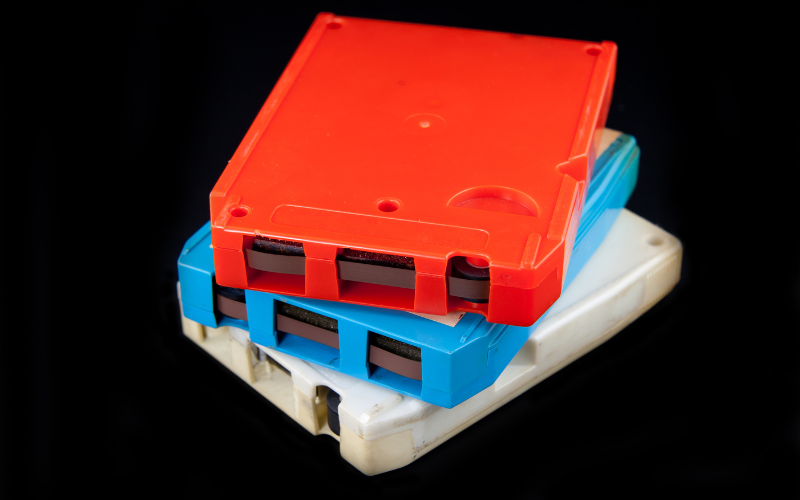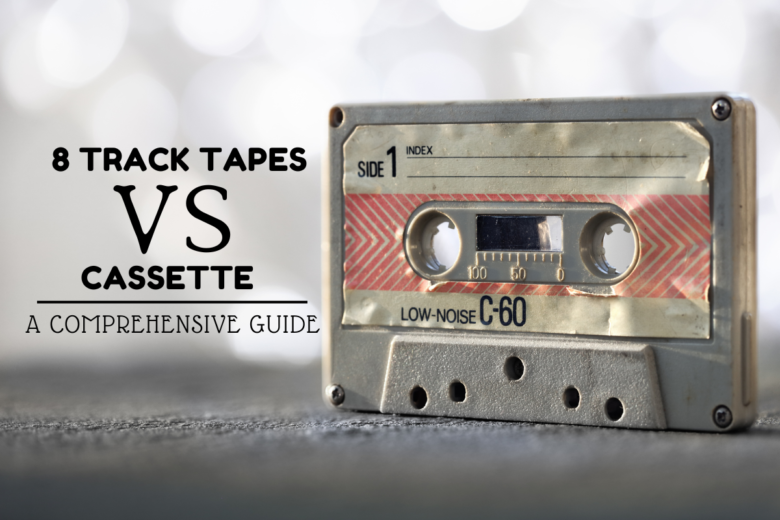8 Track Tapes vs. Cassette What’s the Difference?
Before CDs and DVDs, there were cassette tapes and 8-track cartridges.
These two formats were hands down, the most popular media formats in the late ‘60s until the mid-’80s.
If you lived your teenage years during these times, you probably have fond memories of playing cassette tapes in your car or portable boombox. You might even have a sizable collection of 8-tracks at home.
Ready for a quick history lesson mixed with a dose of nostalgia? This article will take you down memory lane, walking you through these popular formats and how they compare.

What are 8 Track Tapes?
The 8-track tape was a popular audio recording medium from the 1960s to the early ‘80s.
The medium was invented in 1964 by a team led by William Powell Lear, the owner of the aircraft manufacturer Lear Jet Corporation. Its design was based on an earlier cartridge called the Fidelipac cartridge, created by George Nash.
The 8-track cartridge was composed of a single magnetic strip that was 1/4 inch wide. The dimensions made it possible to record up to eight channels onto the strip, hence the name. This gave the cartridge superior audio recording quality and fidelity despite its relatively compact size.
The 8-track tape quickly became a game-changer for music lovers and, at the time, was revolutionary. It was far more portable than a vinyl record, the other major music media then. Thus, it allowed people to store music and play them in their car or at the park instead of relying on random tracks that played on the radio.
To further spread the usage of 8-track tapes, William Lear made a deal with the Ford Motor Company to have 8-track tape players as default in all cars from 1966 onwards. A year later, other car manufacturers followed suit.
This led to an explosion in the popularity of 8-track tapes. By the mid-’70s, it was everywhere. Radio stations also gradually adopted the 8-track as their medium of choice for playing music on-air, replacing vinyl.
In the early 1980s, there was a noticeable decline in the sales of 8 tracks. Cassette tapes had arrived and were quickly becoming the dominant new media of the decade.

What are Cassette Tapes??
Like 8 tracks, cassettes were also an analog audio storage medium that used magnetic tapes.
It was composed of two spools of magnetic tape encased in a plastic shell with dimensions of roughly 4 x 2.5 x 0.5 inches. The tape supported two stereo tracks, each played in opposite directions. This allowed cassette tapes two have two “sides” for playback.
The cassette tape was invented in 1962 by Phillips, roughly the same time that the 8-track was also being developed. However, the initial sound quality was inferior to the 8-track, so the format didn’t get widespread attention.
That all changed during the 1970s when the cassette player improved dramatically. The compactness of the cassette further fueled its popularity, as more people opted to play music on portable devices like boomboxes (and later on, Walkmans).
From the ’80s until the late ’90s, cassettes dominated the music scene. Only when CDs were eventually introduced did cassette tapes wane in popularity.

What’s the Difference Between 8 Tracks and Cassettes
Now that we’ve discussed these two formats, let’s put them side-by-side. Here are some of the biggest differences between cassette vs. 8-track cartridges that you need to be aware of.
Size
The most significant difference between 8-track tapes vs. cassette tapes is the size.
The physical dimensions of a typical 8-track are around 5.25 x 4 x 0.9 inches. In contrast, the size of a cassette tape is just a fraction of that – at 4 x 2.5 x 0.4 inch.
You can also see the size difference in the width of the magnetic tape itself. An 8-track has a 6.35mm tape, while a cassette has 3.81mm.
When you compare 8-tracks and cassette tapes in terms of capacity, 8-tracks could store around 80 minutes of audio.
On the other hand, a cassette tape could store up to 120 minutes, depending on the format.
Compactness is one of the biggest advantages of a cassette tape vs. 8-track cartridges. Since cassettes were smaller and thinner, they were easier to carry. As portable music players like the Walkman became prominent, the public preferred the compact cassette tape even more.

Sound Quality
Now, let’s compare the most important metric – the sound quality of 8-track tapes vs. cassette tapes.
The 8-track produced excellent audio playback for the era. It had a playback speed of around 3 3/4 inches of tape per second, which was capable of achieving a frequency of 12 kHz.
However, the biggest drawback of an 8-track is its notorious “clicking” sound.
See, an 8-track divides audio into distinct programs. If an entire album couldn’t be split cleanly into these programs, some songs would inevitably get cut in the middle. This manifests as a noticeable click while you’re listening to the track.
Unfortunately, these breaks got in the way of the listening experience. Many record producers got around this by rearranging the tracks so that the clicks coincide with empty audio. But this wasn’t always doable.
Many 8-tracks also had a problem with sound artifacts like warbling or fluttering. This resulted from cramming multiple tracks onto the 1/4-inch magnetic tape, which often got out of alignment. The padding on most 8-tracks (used for aligning the tape) also wore out often.
Alternatively, the main draw of a cassette is that it suffered none of these limitations. You can store around 45 to 55 minutes of continuous audio on one side, with no clicking or interruptions.
The fixed head of the tape also meant that a cassette tape was more stable during playback. Thus, sound artifacts were minimized.
However, when comparing 8-track vs. cassette tapes, the sound quality is vastly better on the 8-track. The smaller tape size and slower playback speed compared to an 8-track also gave it less fidelity overall.

Number of Tracks
There are eight tracks on an 8-track cartridge, as the name suggests, all placed on a ¼ inch magnetic strip. When reviewing an 8-track vs. cassette player, combined with a fast playback speed, you’ll see that sound quality is comparatively better.
The 8-track also has a single tape spool that loops endlessly. It’s largely why you don’t need to change “sides” with a cartridge – it just plays continuously.
On the other hand, a cassette tape has four tracks, divided into two sets of stereo tracks. One pair is played when the tape moves in one direction while the other plays in the opposite. This gives the cassette its characteristic side A and B playback.
Rewind ability
One of the selling points of the cassette tape is that you can rewind it. Thus, you can repeat a song that you want to hear again in just a few seconds. And most cassette players did this reliably, too.
An 8-track only plays in one direction, so you can’t rewind it. To hear a song again, you’d have to play the entire album end-to-end, including all the flaws like clicks and unintended fade-outs.
However, this does have an advantage. It means you can play an 8-track cartridge continuously. In contrast, you must rewind a cassette player to the first song to hear the entire thing again.

Reliability
The biggest drawback of an 8-track vs. cassette tape is reliability.
The 8-track tape was relatively fragile. This was because the design of the tape caused the magnetic strip to slide against each other, causing friction. They also suffered from problems like alignment.
Cassette tapes were much more durable. It used a fixed head, which meant there were no alignment problems. The transport system was also simpler, thus eliminating looping problems.
Usage
While both 8-tracks and cassette tapes had the same capabilities as an audio storage medium, they had slightly different use cases.
The 8-track cartridge was mainly a music storage medium used by recording companies to sell portable, high-fidelity music that could be played on the go.
Cassette tapes, meanwhile, were primarily a home recording tool. That’s why plenty of cassette recorders were available at the time. Of course, music companies eventually switched to cassettes when 8-tracks declined in popularity.

Digitize Your Audio Files with EverPresent
Whether you prefer cassettes over 8-tracks or vice versa, one thing’s certain – these storage media won’t last forever. Eventually, wear and tear will get the best of them.
For this reason, transferring your 8-track and audio cassettes to digital is wise. That way, you’ll always have digital copies of your precious recording.

